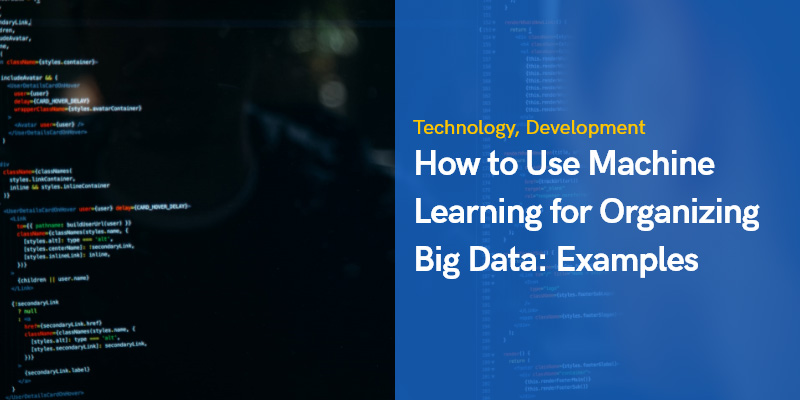
How to Use Machine Learning for Organizing Big Data in 5 Steps
When machine learning comes into play with Big Data, the game goes to the next level. Big Data (next referred to as BD) examines various ways to systematically extract knowledge useful for solving business tasks from huge masses of information. To do this, there are different algorithmic processes for obtaining operational info.
BD specialists work with raw unstructured information, the processing of which is used to support decision-making. Analytics includes validating, transforming, cleaning, and modeling information.

Thus, Big Data involves huge datasets that are also characterized by diversity and high update rates. To effectively use and integrate the machine learning principles for organizing Big Data, we should understand from which sources it comes and how it can be used.
From Which Sources Do BD Come?
All the info is collected from many alternative sources. Ordinary users carry out many activities online, from business communications to shopping and social networking. Billions of connected devices and embedded systems around the world also create, collect and share IoT data every day. Some main sources of BD are:
- Social networks;
- Data Clouds;
- Websites;
- Internet of things.
Content collection and processing are two key methods of working with BD. The first involves collecting info and giving a clear explanation to it. Sorting and processing information reveal unseen patterns and signs that may give some insights into decision-making in almost every business sphere. For instance, using pattern identification and giving forecasts.
However, to integrate ML mechanisms (hereinafter referred to as ML) and process BD effectively, you need powerful software solutions.
Companies are now exploring synthetic data generation to maintain data integrity without compromising user privacy.
If you are searching for a software development company to get this job done, yellow systems is always at your service.
5V of Big Data
Working with BD is associated with five basic principles (V’s of Big Data):
- Volume: The amount of info that companies collect is truly enormous, so volume becomes a critical factor in analytics;
- Velocity: Almost everything that happens around us (search queries, social networks, etc.) generates new content very quickly, many of which can be used in decision-making;
- Variety: The info generated is very diverse and may be presented in a lot of formats such as videos, text, databases, numbers, charts, etc. Understanding the types of BD is key to unlocking its value;
- Veracity: High confidence info contains numerous facts that can be precious for analysis and that add some value to the final outcome. Low confidence info involves meaningless content, which is called noise;
- Value: the possibility to transform BD into valuable solutions.
The essence of machine learning
ML explores the construction and optimization of algorithms whose task is to predict unexpected/future data. Empowered by cloud computing, it ensures the flexibility of the process and involves multiple data, whatever the source is. ML algorithms could be integrated into every step of working with BD, including the following:
- Data segmentation;
- Data analysis;
- Modeling.
By going through these steps, you can get a big picture with valuable conclusions and patterns, that are then classified and converted into a clear form. Merging machine learning and BD is an endless process. The assigned algorithms are checked and improved with the time as info enters the system.

In general, professional ML is applied to follow up with the ever-increasing and changing flow of info. ML algorithms process the emerging content and determine patterns associated with it, which then are converted into valuable conclusions that could be incorporated into the business flow to accelerate some stages of the decision-making process.
How to Use ML algorithms for Big Data
Marketing Automation
The customer base is the heart of any venture. Every company has to master the communication techniques and easily get in touch with the customers via the available channels. ML applies complex algorithms to accurately predict customer wishes and actions.
Backed by ML and BD, marketing automation can leverage sentiment analysis, customer segmentation, and direct advertising efforts through personalized messaging to meet clients' expectations.
ML is often used by media and entertainment specialists to accurately determine the tastes of the audience and deliver the relevant content.
Text Sentiment Analysis
Sentiment analysis is a powerful tool for launching a new product or introducing new features. ML models trained on big data allow you to accurately predict the reaction of customers: whether they will love the product or completely ignore it.
Predicting results are possible at the very beginning of product development! This allows you to change the design or marketing strategy according to the needs of the market.
Recommendation systems
Making product recommendations is like an art: it requires subtlety and a robust combination of ML techniques with BD. This combination is best integrated into streaming services: it merges context with behavioral predictions to influence user experience, enabling companies to generate effective customer offers.
You can improve app performance, improve user engagement, and identify issues that impact user experience with HeadSpin's data science-driven platform. Data science capabilities from HeadSpin can help you stay ahead of the competition and meet your business goals.
To create a good product recommendation, the system must have a clear understanding of the wishes and needs of both the customer and the company. Much of this info can be collected from social networks, web forms, location history, and a variety of other sources.
By correlating data with specific, unique human needs and other customer activity, ML-based recommendation systems provide businesses with an automated marketing process. For example, Netflix uses them extensively to offer the right content to viewers.
Risk management
With the rapid development of data collection and computing power, ML is becoming an integral part of business decision-making. Its application to risk management has laid the foundation for a new generation of improved predictive models.
Risk management is one of the top applications for machine learning and big data. For instance, using them to automate bank scoring and digitize key stages of credit score evaluation can significantly reduce the costs of a financial institution. The most useful ML methods in this area are regressions, decision tree diagrams, and neural networks.
Deciphering patterns
ML is perfect for business spheres, in which knowing customer wishes and actions may bring valuable results. For instance, in healthcare and pharmaceuticals, where you need to process a lot of info. ML techniques detect diseases at an early stage and allow hospitals to better manage services by analyzing past health reports, pathological reports, and patient histories. This improves diagnostics and, in the long run, stimulates medical research.
To sum up
Machine learning is an essential part of Big Data and is used to transform data into useful knowledge. As data collected from different sources is processed by ML algorithms, the system learns and gets better with time.
The key to successfully leveraging ML is through comprehensive data integration, to establish predictive models that accurately represent user behavior, as well as the changing situation and trends.
Although most companies are still working on the basic level of ML, it is a promising technology that can be used to create more powerful and flexible solutions. Ongoing research and development efforts will ensure that the features of this emerging technology are improved, making it more effective and efficient at predicting and organizing the future.
Recommended Posts

WordPress Version Control: A Comprehensive Guide in 2023
February 14, 2023

